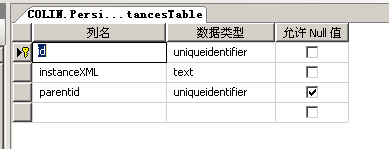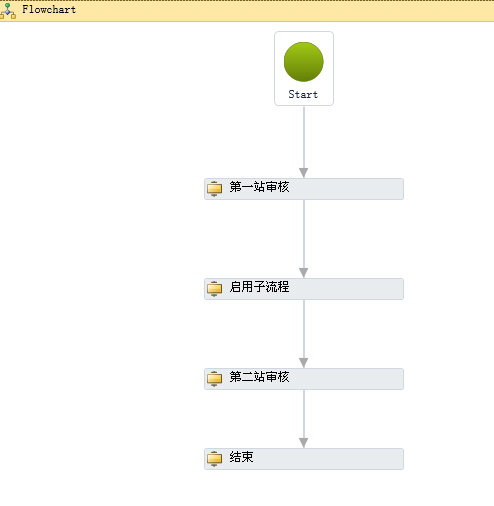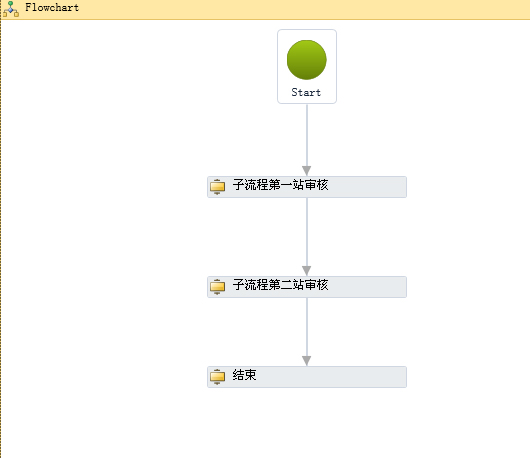在WF 4.0中,存在不同种类的流程。本文将介绍的子流程如何在主流程中实现的原理,希望对大家有所帮助。
工作流服务中,经常会在主流程启用一些子流程。我在审批流程中经常会使用bookmark来暂停流程,这篇文章,将结合bookmark来实现主流程启动子流程。
使用以前的一篇WF4.0自定义持久化中的自定义的持久化。不过数据表中加入了一个字段parentid,用于标识父流程:

下面用一个流程实例为例说明主流程是如何启用子流程,子流程又是如何返回主流程的,主流程如下:

***个节点“***站审核”和第三个节点“第二站审核”都是BookMark书签,附BookMark的代码如下:
代码
public sealed class Read<TResult> : NativeActivity<TResult>
{
public Read()
: base()
{
}
public string BookmarkName { get; set; }
// Define an activity input argument of type string
public InArgument<string> Text { get; set; }
// Must return true for a NativeActivity that creates a bookmark
protected override bool CanInduceIdle
{
get { return true; }
}
protected override void Execute(NativeActivityContext context)
{
context.CreateBookmark(this.BookmarkName, new BookmarkCallback(this.Continue));
}
void Continue(NativeActivityContext context, Bookmark bookmark, object obj)
{
this.Result.Set(context, (TResult)obj);
}
- 1.
- 2.
- 3.
- 4.
- 5.
- 6.
- 7.
- 8.
- 9.
- 10.
- 11.
- 12.
- 13.
- 14.
- 15.
- 16.
- 17.
- 18.
- 19.
- 20.
- 21.
- 22.
- 23.
- 24.
- 25.
第二个节点“启用子流程”,它是一个自定义的节点,代码如下:
代码
public sealed class CallChild : Activity
{
public string FlowName { get; set; }
public CallChild()
{
base.Implementation = new Func<Activity>(CreateBody);
}
public Activity CreateBody()
{
return new Sequence
{
DisplayName = "子流程",
Activities =
{
new ChildCodeActivity
{
FlowName=this.FlowName
}
,
new Read<string>
{
BookmarkName="CallChild",
}
} }; } }
- 1.
- 2.
- 3.
- 4.
- 5.
- 6.
- 7.
- 8.
- 9.
- 10.
- 11.
- 12.
- 13.
- 14.
- 15.
- 16.
- 17.
- 18.
- 19.
- 20.
- 21.
- 22.
- 23.
- 24.
- 25.
- 26.
- 27.
- 28.
- 29.
注意上面的ChildCodeActivity类,实际上是在ChildCodeActivity中启动子流程的,ChildCodeActivity后面是一个书签,用于暂停主流程。当子流程完成后,在子流程中恢复这个书签,子流程结束,主流程继续往下跑。这个活动中有一个FlowName属性,用于表示是启用哪个子流程。ChildCodeActivity代码如下:
代码
sealed class ChildCodeActivity : CodeActivity
{
// Define an activity input argument of type string
public string FlowName { get; set; }
// If your activity returns a value, derive from CodeActivity<TResult>
// and return the value from the Execute method.
protected override void Execute(CodeActivityContext context)
{
Guid ChildGuid;
ChildGuid = WorkFlowRun.CreateAndRun(FlowName);
InstancesTable obj = InstancesTableBiz.GetInstancesTable(ChildGuid);
//取得子流程的id
obj.parentid = context.WorkflowInstanceId;
InstancesTableBiz.UpdateInstancesTable(obj);//跟新父流程id
}
}
- 1.
- 2.
- 3.
- 4.
- 5.
- 6.
- 7.
- 8.
- 9.
- 10.
- 11.
- 12.
- 13.
- 14.
- 15.
- 16.
WorkFlowRun.CreateAndRun(FlowName)根据FlowName启动相应的子流程,并得到实例的Guid。并将子流程的parentid修改改成主流程的guid。
子流程的示例如下:

#T#
子流程的***个节点“子流程***站审核”和第二个节点“子流程第二站审核”也都是BookMark书签。
***一个节点是“结束”。这个节点也至关重要,因为我是使用这个节点,从子流程中返回到主流程的。因此,每个子流程都会有End节点,它的代码如下:
代码
public sealed class End : CodeActivity
{
// Define an activity input argument of type string
public InArgument<string> Text { get; set; }
// If your activity returns a value, derive from CodeActivity<TResult>
// and return the value from the Execute method.
protected override void Execute(CodeActivityContext context)
{
// Obtain the runtime value of the Text input argument
string text = context.GetValue(this.Text);
Guid id = context.WorkflowInstanceId;
InstancesTable Obj = InstancesTableBiz.GetInstancesTable(id);
if (Guid.Empty != Obj.parentid)//如果是子流程,返回父流程
{
WorkFlowRun.Submit(Obj.parentid, "ParentProcess", "returnMain");
}
}
}
- 1.
- 2.
- 3.
- 4.
- 5.
- 6.
- 7.
- 8.
- 9.
- 10.
- 11.
- 12.
- 13.
- 14.
- 15.
- 16.
- 17.
- 18.
- 19.
这是我思考出的在WF4.0中一个启用子流程的方案,如果你有什么更好的方案和建议,请给我留言,谢谢。
原文标题:WF4.0中实现子流程
链接:http://www.cnblogs.com/zhuqil/archive/2010/01/31/SubProcessDemo.html

























